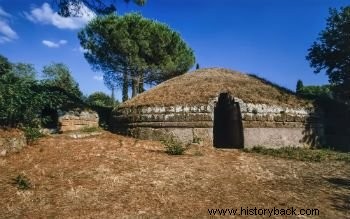The Etruscans represent one of the ancient civilizations that inhabited the Italian peninsula from the 9th century BC, before the Romans. They developed an original culture, and for the time were well evolved in terms of their art (crafts, architecture, sculpture) and engineering.
Although the Etruscans are little known, compared to the Romans and Greeks, they were one of the most powerful civilizations of antiquity and they have a notorious historical, artistic and cultural heritage.
Etruscan Society
Etruscan society was aristocratic and unlike Greek civilization, women participated in public life. The political structure was based on the absolute monarchy, where a sovereign reigned. Below the aristocrats were artisans and merchants, and finally, slaves.
The Etruscan economy was based on agriculture, mining, metal smelting and trade. Navigation was one of the activities explored by the Etruscans mainly for the expansion of trade. With this, they influenced other peoples of antiquity, including the Romans, when they won several battles and conquered the regions of Etruria.
In religion, the Etruscan civilization was polytheistic, that is, they believed in the existence of several gods, among which they stand out:Tínia, Uni and Menrva. The Etruscan alphabet was unlike any of the ancient civilizations, for example Rome and Greece. Supposedly, the Phoenicians influenced it and later, the Etruscans influenced the Greek language and part of the Latin.
Where did they live?
The Etruscans lived on the Italian Peninsula, more precisely in the region of Etruria (present-day Tuscany), east of the Apennine Mountains, between the Tyrrhenian Sea (west) and the Arno (north) and Tiber (south) rivers.
Thus, they inhabited the region of central and northern Italy, which housed several city-states (about 15) of which the following stand out:Volterra, Fiesole, Arezzo, Cortona, Perugia, Chiusi, Todi, Orvieto, Veios, Tarquinia and Fescenia.
According to the excavations carried out, the city-states were highly civilized and had a certain urban planning, with roads, avenues, aqueducts, canals, bridges, walls, monuments, houses and temples. Each of them was ruled by a sovereign and had autonomy over the others.
The origin of the Etruscans is not known for sure. Some historians believe they came from Asia, while others claim that the Etruscans originated from the Italian Peninsula.
Etruscan Art
Etruscan Art houses several ceramic objects (vases, pots, etc.), adornments (jewels from earrings, necklaces and bracelets), sculptures (statues), architecture (temples, tombs, necropolises, bridges, walls, etc.) and painting. (frescos), with the most used materials being terracotta, wood, stone, clay, metal, bronze and ivory.
 Etruscan Necropolis
Etruscan Necropolis
Italians, Etruscans and Greeks
Although they inhabited at different times, the Italians, the Etruscans and the Greeks were the first settlers of the Italian peninsula.
The Italians arrived on the peninsula in 2000 BC. occupying the central region, called Lazio. The Etruscans inhabited the central part, expanding their domains to the north of the peninsula from 9 BC onwards.
Finally, the Greeks arrived on the peninsula from 800 BC onwards. and colonized and founded some cities in the southern region, such as Naples and Syracuse. This region became known as Magna Graecia.
Learn more about Ancient Greece.
The Etruscans and the Rise of Rome
The Etruscans exerted great influence on Roman society, from culture, arts, rituals and social patterns. It is worth remembering that the Italiotas inhabited the Italian peninsula, from 2000 a. C. and founded several villages.
Then, around the 7th century BC, Rome was consolidated as a city with the arrival of the Etruscans, from the increase in trade. Although the Etruscans resisted for a long time, their city-states were not united.
Thus, the Etruscans, the Greeks and the Romans fought several battles, however, in the 3rd century BC, the Romans won the war and held power over the city. With this, the Etruscan culture undergoes a “Romanization”, however, several aspects were preserved which were added to the Roman culture.
Learn about Ancient Rome, the Roman Republic, and the Roman Empire.
Fun fact:Did you know?
For the Etruscans, they were the rasena , while the Romans called them tusci or Etrusci . In turn, the Greeks called the Etruscans Tyrrenes hence the name of the Tyrrhenian Sea, west of the Italian peninsula.
